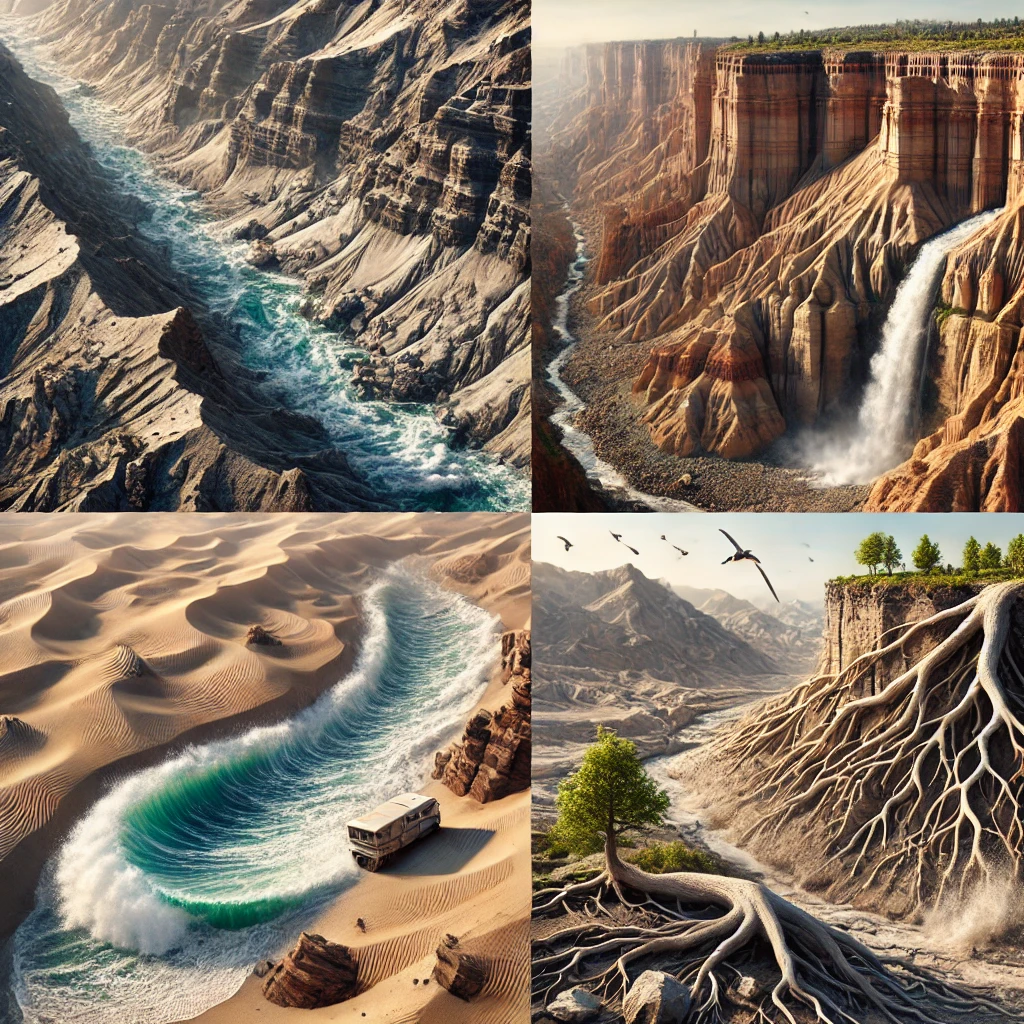How Do Erosion and Weathering Affect the Earth?
Our planet's surface is constantly changing due to various natural processes. Two primary processes responsible for these changes are weathering and erosion. While they often work together to break down and transport materials, they are distinct in their mechanisms and effects.
Weathering refers to the breakdown of rocks, soils, and minerals through direct contact with the Earth's atmosphere. This process occurs in place, meaning the materials are not moved elsewhere during the breakdown.
Erosion, on the other hand, involves the movement of rock particles and soil by agents such as wind, water, ice, or gravity. This means that after the initial breakdown (which can be due to weathering), the particles are transported to new locations.

Key Differences Between Weathering and Erosion
Unique Insights
While both processes play crucial roles in shaping our environment, it's essential to understand their interplay. For instance, weathering weakens rocks, making them more susceptible to erosion. Human activities, such as deforestation and construction, can accelerate both weathering and erosion, leading to environmental challenges like soil degradation and loss of fertile land.
Interactive Quiz
Test your understanding with this quick quiz:
1. What is the primary difference between weathering and erosion?
A) Weathering involves movement; erosion does not.
B) Erosion involves movement; weathering does not.
C) Both involve the movement of materials.
D) Neither involves the movement of materials.
Answer: B) Erosion involves movement; weathering does not.
2. Which of the following is an example of chemical weathering?
A) Freeze-thaw cycles causing rock cracks.
B) Plant roots breaking rocks.
C) Rust formation on rocks due to oxidation.
D) Wind carrying sand particles.
Answer: C) Rust formation on rocks due to oxidation.
3. Glaciers moving rocks and soil as they advance is an example of:
A) Physical weathering
B) Chemical weathering
C) Erosion
D) Biological weathering
Answer: C) Erosion


FAQs on Erosion vs Weathering: What Sets Them Apart?
1. What is the fundamental difference between weathering and erosion?
The primary difference lies in their actions. Weathering is the process of breaking down rocks, soil, and minerals while they remain in their original place (in-situ). Erosion, on the other hand, is the process that moves these broken pieces (sediments) from one location to another. In simple terms, weathering breaks it, and erosion takes it.
2. What are some real-world examples of weathering and erosion?
You can see examples of both processes all around you.
- Examples of Weathering: A rock cracking in cold climates due to ice formation (physical weathering), iron gates developing rust (chemical weathering), or a tree root splitting a pavement block (biological weathering).
- Examples of Erosion: A muddy river carrying silt downstream (water erosion), wind creating sand dunes in a desert (wind erosion), or a glacier carving out a U-shaped valley (glacial erosion).
3. What are the main types of weathering a student should know?
Weathering is broadly classified into three main types based on the process involved:
- Physical Weathering: This is the mechanical breakdown of rocks into smaller pieces without changing their chemical composition. Common causes include temperature changes (freeze-thaw), abrasion, and pressure.
- Chemical Weathering: This involves the decomposition of rocks through chemical reactions, which changes the mineral composition. Key examples are oxidation (rusting), carbonation, and hydrolysis.
- Biological Weathering: This is weathering caused by living organisms. It can be physical (plant roots) or chemical (acid production by lichens).
4. What are the primary agents that cause erosion?
Erosion is driven by several powerful natural forces known as agents. The most significant agents of erosion are water (in rivers, rain, and ocean waves), wind, ice (in the form of glaciers), and gravity (which causes landslides and mass movements).
5. Can weathering and erosion happen at the same time?
Yes, weathering and erosion often work together and can occur simultaneously. For example, as a river flows, the force of the water transports loose sediment (erosion), while those same sediments scrape against the riverbed, breaking down more rock (a type of physical weathering called abrasion). Weathering provides the material that erosion then transports.
6. Is it possible for erosion to happen without weathering occurring first?
Generally, no. Erosion is the transport of weathered materials (like sand, silt, or clay). For erosion to have something to move, the parent rock must first be broken down into smaller, transportable particles. This breakdown is the job of weathering. Therefore, weathering is a necessary prerequisite for most forms of erosion.
7. How can plants be responsible for both causing weathering and preventing erosion?
This is an excellent example of nature's complexity. On one hand, a plant's roots can grow into cracks in rocks, exerting pressure and splitting them apart, which is a form of biological weathering. On the other hand, a dense cover of vegetation and its extensive root network bind soil particles together, protecting the soil from being carried away by wind and water, thus effectively preventing erosion.
8. How do human activities like deforestation and construction accelerate erosion?
Human activities can dramatically speed up erosion. Deforestation removes the trees and plant cover that hold soil in place, leaving it exposed and vulnerable to being washed or blown away. Similarly, construction, mining, and agriculture disturb the land, removing protective vegetation and loosening the soil, which makes it much easier for agents like water and wind to erode it at an unnaturally high rate.
9. Why is deposition an important part of the erosion process?
Deposition is the final step in the erosion process. It is the laying down or settling of the sediments that were transported by wind, water, or ice. Without deposition, new landforms would not be created. It is responsible for forming important features such as river deltas, beaches, sand dunes, and fertile floodplains, which create new habitats and rich agricultural land.










